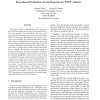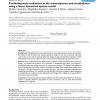369 search results - page 44 / 74 » Bayesian multiscale analysis for time series data |
ICDM
2008
IEEE
14 years 2 months ago
2008
IEEE
Zero-norm, defined as the number of non-zero elements in a vector, is an ideal quantity for feature selection. However, minimization of zero-norm is generally regarded as a combi...
RTSS
2003
IEEE
14 years 25 days ago
2003
IEEE
This paper presents a quantification of the timing effects that advanced processor features like data and instruction cache, pipelines, branch prediction units and out-oforder ex...
CSDA
2010
13 years 7 months ago
2010
A two component parametric mixture is proposed to model survival after an invasive treatment, when patients may experience different hazards regimes: a risk of early mortality dir...
BMCBI
2007
13 years 7 months ago
2007
Background: Modelling of time series data should not be an approximation of input data profiles, but rather be able to detect and evaluate dynamical changes in the time series dat...
PERCOM
2007
ACM
14 years 7 months ago
2007
ACM
Abstract. A major challenge in pervasive computing is to learn activity patterns, such as bathing and cleaning from sensor data. Typical sensor deployments generate sparse datasets...


